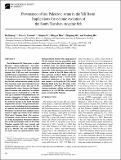Provenance of late Paleozoic strata in the Yili Basin : implications for tectonic evolution of the South Tianshan orogenic belt
Abstract
The Yili Basin in NW China preserves a late Paleozoic volcano-sedimentary succession, the provenance of which helps to constrain the tectonic evolution of the South Tianshan orogenic belt. U-Pb ages and trace-element and Hf isotopic compositions of detrital zircons from the Late Devonian to earliest early Carboniferous strata in the Yili Basin suggest that the unit contains detritus mainly derived from basement rocks and contemporaneous arc-related volcanic rocks. The age of the unconformable contact between the Dongtujinhe Formation and underlying arc-related volcanic rocks is constrained to ca. 310 Ma. This age is consistent with published data for tectonic exhumation of high- to ultrahigh-pressure ([U]HP) metamorphic rocks from the northern margin of the South Tianshan orogenic belt. Zircon U-Pb ages from the sedimentary rocks, including clasts in conglomerate, indicate that detritus of the Dongtujinhe Formation was derived from multiple sources related to uplift and erosion of the southern Yili-Central Tianshan block. The presence of abundant eclogite clasts in the conglomerate of the Keguqinshan Formation indicates that (U)HP metamorphic rocks in the South Tianshan orogenic belt were exposed and supplied detritus to the southern Yili Basin at ca. 300 Ma. The early Middle Permian clastic rocks are characterized by Early Permian detrital zircons with a single peak at 278 Ma, derived from the postcollision magmatic rocks. During the Late Permian, input of detritus from old volcanic-sedimentary rocks and basement progressively increased. Integration of the provenance data from late Paleozoic strata in the Yili Basin with the time-equivalent northern Tarim and South Tianshan regions provides a record of the northward subduction of the South Tianshan oceanic crust beneath the Yili-Central Tianshan block in the Late Devonian to late Carboniferous (380-310 Ma), followed by continent-continent collision and final amalgamation at ca. 310-300 Ma, with postcollisional extension in the Permian.
Citation
Huang , H , Cawood , P A , Ni , S , Hou , M , Shi , Z & Hu , X 2018 , ' Provenance of late Paleozoic strata in the Yili Basin : implications for tectonic evolution of the South Tianshan orogenic belt ' , Geological Society of America Bulletin , vol. 130 , no. 5-6 , pp. 952-974 . https://doi.org/10.1130/B31588.1
Publication
Geological Society of America Bulletin
Status
Peer reviewed
DOI
10.1130/B31588.1ISSN
0016-7606Type
Journal article
Description
This research was supported by the 973 Program under grant no. 2015CB453000, the National Natural Science Foundation of China (41502109), the Cultivating Program of Middle-Aged Key Teachers of Chengdu University of Technology (KYGG201718), Innovation Team of Sedimentary Geology of Chengdu University of Technology (KYTD201703), and by the China Postdoctoral Science Foundation (2015M582528). Cawood acknowledges support from the Australian Research Council grant FL160100168.Collections
Items in the St Andrews Research Repository are protected by copyright, with all rights reserved, unless otherwise indicated.

